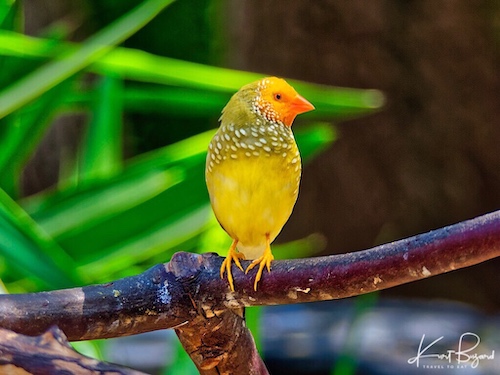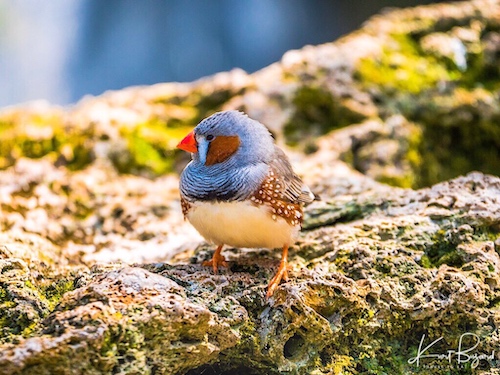
When we visited Vancouver, we came across the most amazing little conservatory. The Bloedel Conservatory is essentially a large bird cage located at the peak of Vancouver in Queen Elizabeth Park. There are 120 exotic mainly tiny birds and over 500 kinds of tropical plants inside the dome. This elaborate cage for the birds and plants reveals something very ancient and primal to humans, the desire to bring the outdoors inside. In this case, these are exotic birds and plants that would not survive in the relatively harsh climate of Vancouver but even in antiquity local birds were kept by the wealthy, in particular for harems and by mariners to find land in the open sea. In medieval Europe, bird keeping was mostly for the wealthy. Kings, Queens and the Clergy would often keep parrots. The Sumerians, the oldest civilization known to have kept written records, had a word, subura, for birdcage. Do we bring birds inside our homes because we are unable to enter theirs? Do we try to tame wild nature because we fear we can never tame our own? These bits of philosophy are thanks to a beautiful essay on caged birds by Jerry Dennis, found below. For the purpose of this post, I thought we would just enjoy these birds, in one of the best settings for an aviary I have yet to see.
The Plants






I am not going to focus on the plant life at the Bloedel Conservatory except to remark on their exceptional beauty.
The Birds
They name the larger birds although I think the tiny ones steal the show, especially for the children.


The Eclectus Parrot (Eclectus roratus) is a parrot native to the Solomon Islands, Sumba, New Guinea and nearby islands, northeastern Australia, and the Maluku Islands (Moluccas). It is unusual in the parrot family for its extreme sexual dimorphism of the colors of the plumage; the male having a mostly bright emerald green plumage and the female a mostly bright red and purple/blue plumage.

Art is a handsome devil and he knows it. This species occurs in Venezuela, Peru, Brazil, Bolivia, and Paraguay. The range extends slightly into Central America, where it is restricted to Panama. Although they were nearly wiped out in Trinidad due to human activity during the 1970s, a recent program of reintroduction has proved successful.


The white cockatoo (Cacatua alba), also known as the umbrella cockatoo, is a medium-sized all-white cockatoo endemic to tropical rainforest on islands of Indonesia. When surprised, it extends a large and striking head crest, which has a semicircular shape (similar to an umbrella, hence the alternative name).

The grey parrot is native to equatorial Africa, including Angola, Cameroon, Congo, Ivory Coast, Ghana, Kenya, and Uganda. The species is found inside a range from Kenya to the eastern part of the Ivory Coast. It is recorded that a governor of an African colony presented an African grey parrot to Queen Marie Antoinette. King Henry VIII also owned an African grey.
Canary

The domestic canary, often simply known as the canary (Serinus canaria forma domestica), is a domesticated form of the wild canary, a small songbird in the finch family originating from the Macaronesian Islands (The Azores, Madeira and the Canary Islands). Canaries were luxury pets about 500 years ago. When the Spaniards took over the Canary Islands, they discovered the lovely songbirds there and sold them at high prices to the wealthy of Europe. It became fashionable for a lady to receive visitors with a canary perched on her forefinger.

The Border Canary Bird or also called Border Fancy Canary is one of the most popular birds today. It is commonly bred for its attractive colorful physical appearance rather than for its songs. It is nicknamed “Wee Gem” because this bird is tiny, compact and hardy. It displays a well-rounded head and alert lively eyes. It has a round body with very glossy plumage. Information is scarce as to the history and background of the border canary bird other than it is said to have evolved in the late 1700’s or early 1800’s along the borders of northern England and Scotland.
Budgie



There are actually two types of budgies commonly seen in aviculture, Australian (often called American parakeets) and English budgies. They are quite different in size and appearance. American parakeets are the birds you usually see in pet stores. English budgies are the birds seen in exhibitions and shows. They are quite a bit larger than the standard budgerigar and their appearance is strikingly different. The species was first recorded in 1805, and today is the third most popular pet in the world, after the domesticated dog and cat. Found wild throughout the drier parts of Australia, prior to colonisation they had survived harsh inland conditions for five million years.
Estrildid Finches

The estrildid finches are small birds of the Old World tropics and Australasia. They can be classified as the family Estrildidae (waxbills, munias, and allies), or as a subfamily within the family Passeridae, which strictly defined comprises the Old World sparrows. They are gregarious and often colonial seed eaters with short, thick, but pointed bills. They are all similar in structure and habits, but vary widely in plumage colours and patterns. Because they are small 3.3–6.7 inches, chirpy and colorful, they have become popular pets. The business of keeping small exotic caged birds by the middle and upper class corresponds roughly with the “Age of Discovery” of the 15th and 16th centuries, the discovery of Canaries from the Canary Islands by Portuguese sailers and subsequent discoveries of exotic finches in Australia and Africa, as always spurred by a completion as to who has the most exotic bird. Cagebirds such as canaries, budgerigars, cockatoos, lovebirds, quails, finches, and parrots became popular pets, whether for their song, their behaviour, their colorful plumage, or their ability to mimic speech. In particular, Estralid Finches have become prized companions, despite or because of, their relative obscurity among the general population.

The double-barred finch (Taeniopygia bichenovii) is an estrildid finch 3.9–4.3 inches (10–11 cm) long, found in dry savannah, tropical (lowland) dry grassland and shrubland habitats in northern and eastern Australia. It is sometimes referred to as Bicheno’s finch or as the owl finch, the latter of which owing to the dark ring of feathers around the face.

The cut-throat finch (Amadina fasciata) is a common species of estrildid finch found throughout Africa, 5 inches (12.7 cm) long. It is also known as the bearded finch, the ribbon finch, the cut throat, and the weaver finch. I rather like the dusky brown color with a sash of red.

The star finch (Neochmia ruficauda), 4.5 inches (11.5 cm) is an estrildid bird species found in northern Australia. The star finch is still common in Western Australia and the Northern Territory, however is rare and endangered in Queensland and is extinct in the southern part of that state. Its habitat is threatened by overgrazing of grasslands, removing essential cover for their survival as well as sources of food and water.

The society finch (North America) or Bengalese finch (elsewhere), Lonchura striata domestica or L. domestica, is a popular cage bird not found in the wild. It is a member of the estrildid finch family, 4 inches (10cm) long. Many authorities call it a domestic form of the white-rumped munia (known in aviculture as the striated finch), at least probably, though some state that it originated as a hybrid of this species with others in the genus Lonchura.

The plum-headed finch (Neochmia modesta) also known as cherry finch is a common species of estrildid finch found in Australia. It measures about 6 inches (15 cm) long.

The long-tailed finch (Poephila acuticauda) is a common species of estrildid finch found in Australia; also known as the blackheart finch, shaft-tail finch, Heck’s grassfinch, Heck’s grass finch, and Heck’s finch. it is about 6 inches (15cm) in length. It is a predominantly fawn-colored bird with a pale grey head and prominent black bib and eyes.

The zebra finch (Taeniopygia guttata) is the most common estrildid finch of Central Australia and ranges over most of the continent, avoiding only the cool moist south and some areas of the tropical far north. It can also be found natively in Indonesia and East Timor. The bird has been introduced to Puerto Rico and Portugal. A mature zebra finch is about 4 inches (10 cm) long from the tip of the beak to the end of the tail feathers, making it one of the smaller (though not the smallest) of the finches.
If you find yourself in Vancouver, the Bloedel Conservatory is well worth the visit. I hope you enjoyed the post, please leave a comment.
[mappress mapid=”245″]

